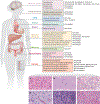YAP, TAZ, and Hippo-Dysregulating Fusion Proteins in Cancer
- PMID: 40491864
- PMCID: PMC12147517
- DOI: 10.1146/annurev-cancerbio-061223-094639
YAP, TAZ, and Hippo-Dysregulating Fusion Proteins in Cancer
Abstract
Gene fusions are well-known drivers of cancer and are potent targets for molecular therapy. An emerging spectrum of human tumors harbors recurrent and pathognomonic gene fusions that involve the transcriptional coactivator YAP1 (which encodes the protein YAP) or its paralog WWTR1 (which encodes the protein TAZ). YAP and TAZ are frequently activated in cancer and are the transcriptional effectors of the Hippo pathway, a highly conserved kinase cascade that regulates diverse functions such as organ size, development, and homeostasis. In this review, we discuss the tumors that have YAP, TAZ, or other Hippo-dysregulating fusion proteins; the mechanisms of these fusion proteins in driving their respective tumors; and the potential vulnerabilities of these chimeric oncoproteins across cancers of many origins. Furthermore, as new YAP1 and WWTR1 gene fusions are discovered, we provide a framework to predict whether the resulting protein product is likely to be oncogenic.
Keywords: Hippo pathway; WWTR1/TAZ; YAP1; cancer; gene fusions; sarcoma.
Figures



Similar articles
-
Hippo pathway effectors YAP1/TAZ induce an EWS-FLI1-opposing gene signature and associate with disease progression in Ewing sarcoma.J Pathol. 2020 Apr;250(4):374-386. doi: 10.1002/path.5379. Epub 2020 Feb 4. J Pathol. 2020. PMID: 31880317
-
Unraveling the Biology of Epithelioid Hemangioendothelioma, a TAZ-CAMTA1 Fusion Driven Sarcoma.Cancers (Basel). 2022 Jun 16;14(12):2980. doi: 10.3390/cancers14122980. Cancers (Basel). 2022. PMID: 35740643 Free PMC article. Review.
-
Genomic Hippo Pathway Alterations and Persistent YAP/TAZ Activation: New Hallmarks in Head and Neck Cancer.Cells. 2022 Apr 18;11(8):1370. doi: 10.3390/cells11081370. Cells. 2022. PMID: 35456049 Free PMC article. Review.
-
TAZ and YAP are frequently activated oncoproteins in sarcomas.Oncotarget. 2016 May 24;7(21):30094-108. doi: 10.18632/oncotarget.8979. Oncotarget. 2016. PMID: 27129148 Free PMC article.
-
Role of the Hippo-YAP/TAZ Pathway in Epithelioid Hemangioendothelioma and its Potential as a Therapeutic Target.Anticancer Res. 2024 Oct;44(10):4147-4153. doi: 10.21873/anticanres.17245. Anticancer Res. 2024. PMID: 39348982 Review.
References
-
- Alberti S, Hyman AA. 2021. Biomolecular condensates at the nexus of cellular stress, protein aggregation disease and ageing. Nat. Rev. Mol. Cell Biol 22:196–213 - PubMed
-
- Anderson WJ, Fletcher CDM, Hornick JL. 2021. Loss of expression of YAP1 C-terminus as an ancillary marker for epithelioid hemangioendothelioma variant with YAP1-TFE3 fusion and other YAP1-related vascular neoplasms. Modern Pathol 34:2036–42 - PubMed
Grants and funding
LinkOut - more resources
Full Text Sources
